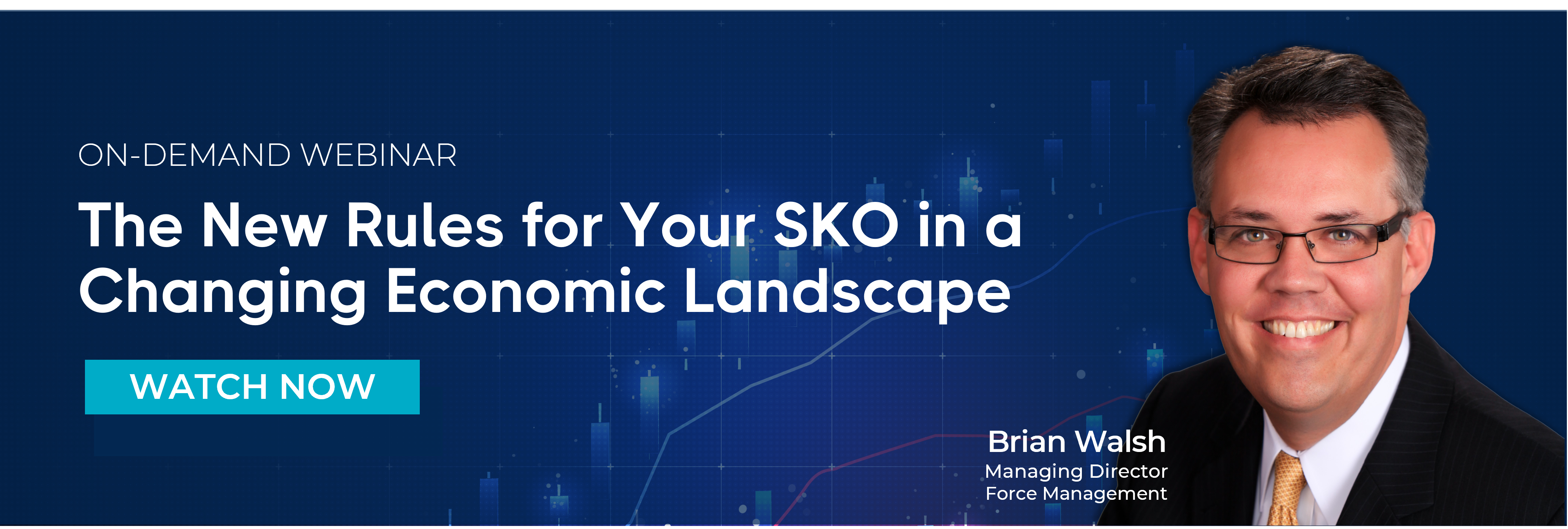
Your SKO: How to Drive Long-Term Adoption & ROI
Categories: Adoption and Reinforcement | Sales Kickoff | Economic Change
With the season for sales kickoffs approaching, the current economy is likely a driving influence on your plan. Given the shifting market dynamics, ensure you use your SKO resources where it matters most, and equip your team to drive lasting results long after the SKO ends.
Affecting real change on sales behaviors requires more than a two-day SKO event or one-off virtual training session. Teams that compete next year, will be the ones who were equipped from the get go, at the SKO, and then supported along the way as they adjusted their sales actions.
In times of economic pressure, elite leaders use their SKO as a critical event to build proficiency around key components of sales effectiveness, whether it be sales messaging, planning, execution or qualification. While the work may start at the SKO event, it’s critical that there’s also a plan to maintain momentum beyond the event, measure ongoing performance and drive the adoption of new sales behaviors.
Create Your Ready-To-Launch Adoption Plan:
The more you can define the plan for adoption on the front end, the better you’ll be able to equip your sales team for success on the back end, long after the SKO has ended. In our engagements, we help sales leaders think through these five key adoption concepts to ensure long-term results:
1. Ensure your sales organization sees the initiative as a priority
When the entire sales organization understands the priority of the strategic sales initiative and how it benefits them, they’ll be far more likely to execute new or shifted sales behaviors. Leadership must communicate the priority of the initiative before and after the SKO. Before launch and during your SKO, articulate your mission and vision for the longevity of the sales initiative. Your team will likely appreciate insight on how you’re planning to support them in hitting revenue numbers in a changing or down economy.
Define how sales teams will be held accountable for and supported in drafting new concepts into their day-to-day sales activities. Sales leaders play a critical role in communicating the priority of their initiative and leading from the front. Here are a few examples:
- Use new language and concepts covered during the SKO in forecasting calls, deal reviews and in communications shared within the entire company (not just the sales organization), including emails, meetings, announcements, etc.
- Set benchmarks for yourself to demonstrate how you’re also applying new methodologies, content and tools to your everyday tasks.
- Remain actively involved in the achievement and recognition of the goals set at your SKO throughout the year.
2. Ensure relevancy
Relevant and immediately usable content, tools and processes are key to onboarding your team quickly and efficiently to a strategy that will help them sell in the current economic environment. How can you make new sales capabilities relevant to what your salespeople do every day, so they’re easier to execute after the fact and against market noise?
Help them make the shift by aligning what’s delivered during the SKO to their everyday responsibilities, sales activities and live opportunities. As you outline the goal of the initiative beyond the event, here are some possible action steps:
- Tailor the training and deliverables of the strategic sales engagement to be relevant to current customer problems and challenges sellers are experiencing as it relates to economic shifts.
- At the same time, develop immediately usable content and tools, by role, to support your sales teams in applying new concepts to live opportunities and reinforcing those actions.
- Define what good looks like in each role so managers, reps and other influencers know who does what, and when, once the SKO ends.
- Provide ongoing learning and integrate technology that reps can use to improve adoption and execution. This also ensures managers have line-of-sight into who’s doing well and who needs their help.
- Find ways to monitor your salespeople’s ability to execute new methodologies or processes so you can celebrate wins and quickly course correct as needed.
3. Make integration essential
To ensure the success of your initiative, consider how new methodologies, content, tools and processes integrate into the baseline curriculum or internal sales structure your teams currently use to move deals forward. Help your team adopt new practices by integrating them into what your salespeople do every day. Here are a few options to consider:
- Develop your initiative around the strategic direction of the company in a way that drafts into your existing sales processes, structure and systems.
- Generate executive alignment around your sales strategy to ensure it will integrate into key marketing and product considerations, as they relate to your sales teams.
- Share custom deliverables with all of your customer-facing organizations (SDR/BDRs, Marketing, Customer Success, etc.) to get your entire organization aligned on new go-to-market messaging and/or buying processes. The integrated deliverables should be tailored to specific roles (i.e., BDRs need different tools than direct reps).
- Implement content and criteria from your initiative into the tools and resources your sales teams use every day, like your CRM.
4. Define the measurement
Is there a plan to monitor ongoing performance after the SKO to course-correct any challenges before your sales team gets too far off track?
Put a focus on the practical and measurable results of your sales initiative to ensure salespeople know what’s expected of them moving forward. Tie the measurable benchmarks of your initiative to your sales organization’s mission critical priorities. It’s helpful to create benchmarks that coincide with 30/60/90 day check-ins and/or a management cadence for deal reviews and coaching sessions. These actions will help you to:
- Monitor and gain line-of-sight into rep execution to ensure they have what they need to drive repeatable results.
- Course correct rep performance to help them change deals at risk into high-value opportunities.
- Provide the support, resources and coaching that enables reps to repeat success and helps your managers speed up time-to-productivity of greener reps or new hires.
5. Enable managers to achieve results through ongoing reinforcement
Reinforcement is achieved primarily through the behavior of front-line managers. This is why we often say that your manager's role in what happens after the SKO is almost more important than what happens during the actual event. Front-line managers will drive the biggest impact in the reinforcement of your sales initiative.
Your managers will be the first to hold your reps accountable for using new tools and methodologies in live opportunities and the first person you look to if you need to minimize execution gaps. Your managers will also be your reps first resource as they face new challenges as a result of economic change.
Here are a few ways you can enable your managers to drive the longevity of your sales transformation initiative:
- Gain widespread management involvement throughout the initiative.
- Enable them to be valuable coaches, capable of teaching repeatable sales skills and effectively developing the individual reps on their teams.
- Articulate that you are looking to them to lead by example by using new concepts themselves, speaking a common sales language and managing via common processes.
- Provide sales managers with “coaching playbooks” that define desired behaviors to be inspected and red flags to remediate.
- Help managers implement a management cadence that will support their ability to drive accountability, reinforcement and adoption long after the SKO ends.
- Share these SKO resources to motivate and align your team on best practices.
6. Identify what’s mission critical for your organization
In order to create lasting change throughout your sales initiative, it’s important to focus your efforts on a select discipline. Too many areas of focus can lead to half-baked progress.
In a changing economy, your priorities should enable your sales team to meet revenue goals. We’re seeing leaders put their focus on one or more of these four mission critical areas of sales effectiveness: Sales Message, Sales Planning, Sales Qualification and Sales Talent. To determine your area of focus, consider which of the areas below you are experience the most pain points:
- Inability to access key decision makers, lower-than-desired margins with a lack of cross-sell and upsell, inability to repeatedly drive high-value outcomes, and falling victim to cost-cutting or “not right now” decisions are all indicators of a lack of effective value messaging.
- Long deal cycles, delayed decisions, last-minute discounting, and sellers wasting time in back and forth negotiations instead of pursuing new business, could indicate a sales qualification issue.
- Inability to build repeatable high-value pipelines, inflexible teams unable to forecast and pivot to avoid margin cuts and losses, resulting in chaos trying to make the number at the end of the quarter are all symptoms of a larger sales planning concern.
- Uncertainty on what individual success looks like, longer-than-ideal time to productivity, lack of cadence and accountability around goals, and managers who are great sellers but lack the leadership skills needed to coach a productive team, could mean that the management of sales talent needs restructuring.
Once you have determined where your sales team could improve the most, plan your SKO adoption activities around the reinforcement of those particular skills.
Define Your Opportunity to Solve Sales Execution Problems
When facing economic challenges, it’s imperative that leaders clearly define success indicators and align behind the highest value priorities for their sales organization. The SKO is your biggest opportunity to equip your sales organization with what’s needed to meet changing market demands.
You invest a considerable amount of resources into your SKO, so ensure that it sticks. Incorporate adoption planning from the early stages. Find out what elite leaders are doing to drive the success of their SKO initiatives by watching this recent conversation with Force Management Managing Director, Brian Walsh. He discusses key factors to consider when planning your SKO in the current economic environment.


